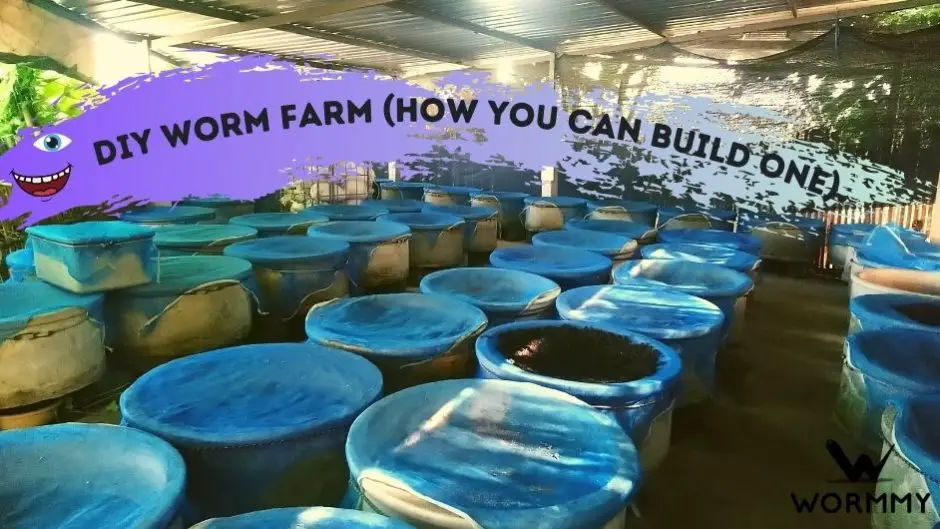

Worm Farming has become more of a necessity than a hobby due to growing concern for environmental protection.
As we are producing more household waste than ever, landfill sites have already started running out of their capacity.
Most of the kitchen waste and food scraps we throw away are biodegradable that can be processed in the backyard with a simple yet effective DIY worm farm. And that’s why you’re here!
You don’t have to be a rocket scientist to make your own worm farm at home.
A little bit of creativity goes a long way. You will always find some items lying around in the corner of your house that you can use to start a worm farm.
Once you have set up your worm farm, you can just sit back and relax.
Let those tiny red wigglers do their job of processing the food scraps into high-quality compost that you can use as organic fertilizer for your kitchen gardening.
But how can you make a DIY worm farm or worm bin? Let’s get started…
First, decide on the capacity of the worm farm that you want.
It depends on the amount of your family’s food waste that determines the number of composting worms and the size of the worm bin that you are going to build.
It’s worth considering the placement and space available for setting up the worm farm.
Will it be and outdoor worm bin or indoors?
This may be determined by a few factors:
Both are a viable option.
The single tray worm bin is the easiest to set up but perhaps harder to maintain and harvest worm castings from.
You might have to spend some time separating worms from the final compost when harvesting the castings.
The multiple tray stacked design takes a little more work to set up (but still easy).
The advantage is worms will very helpfully separate themselves from their old castings as you can easily control their movements by placing food scraps like fruit and vegetable peels into the container you want them to migrate to.
It is space-efficient and allows you to nest the worm bins and your compost worms within.
On the other hand, you can create a continuous flow worm farm like the commercial worm farms do.
This is much more difficult to set up and build. If you wanted to buy one, they’d be expensive too.
But it is much easier to harvest the compost since the equipment automatically separates worm castings from the worms.
Or, you can go old-school style.
Just dig a hole in your backyard garden and fill it with worm bedding, worms, and food waste, and let nature take care of itself.
You won’t even need a container or any worm composting bins!
Now that you have figured out the type, size, placement, and harvest method for your worm farm, let’s gather the items required for this DIY project.
You can’t have a worm farm without worms.
There are various species of worms, but you can’t just use any random species of worms for composting.
The most popular type of worm used for composting is called the red wiggler (Eisenia fetida) that also goes by other names such as red worms, manure worms, and tiger worms.
You can use any container for worm farming as long as it is opaque because worms like to stay in dark.
Make sure that the top bin has a lid on it. There are different types of worm bins available in the market.
Go with the one that meets your composting requirements. We recommend using at least three bins for the best results.
A drilling machine, old newspapers, and of course, organic kitchen waste and food scraps.
Once you have gathered the required items, making a worm farm is quite fun, easy, and interesting. Here’s how we do it:
Here comes the worm food!
But be careful with what you feed to the worms. So, what do worms eat?
Worms eat and love organic food scraps like:
While worms eat these food scraps too, they may be either harmful to worms in large quantities or attract pests like fruit flies or worse (rats!)

It’s time to let the red wigglers or nightcrawlers (whichever compost worms you’ve decided on) into their new home aka your DIY worm bin.
They will bury themselves in the scraps and get started with their work of feeding, pooping, and reproducing.
They normally consume about half the weight of their body in a day.
Don’t overfeed them though, as this estimation is when they are in perfect conditions and as a beginner, things are likely not to be perfect.
Cover the top bin with its lid so that it is dark inside the colony.
Keep checking on the worms regularly to see if they are doing their work of breaking down the foods in your new worm composter.
You will notice the increase in their population and accumulation of worm castings.
Add fresh food to keep them happy and healthy.
Rotate the bins after each harvesting so that the worms can migrate to another container and you can easily harvest worm castings from your worm composting efforts.
Worms will almost always migrate to find something fresh to feed on.
This is the simplest way of building a worm farm all by yourself at a very low cost.